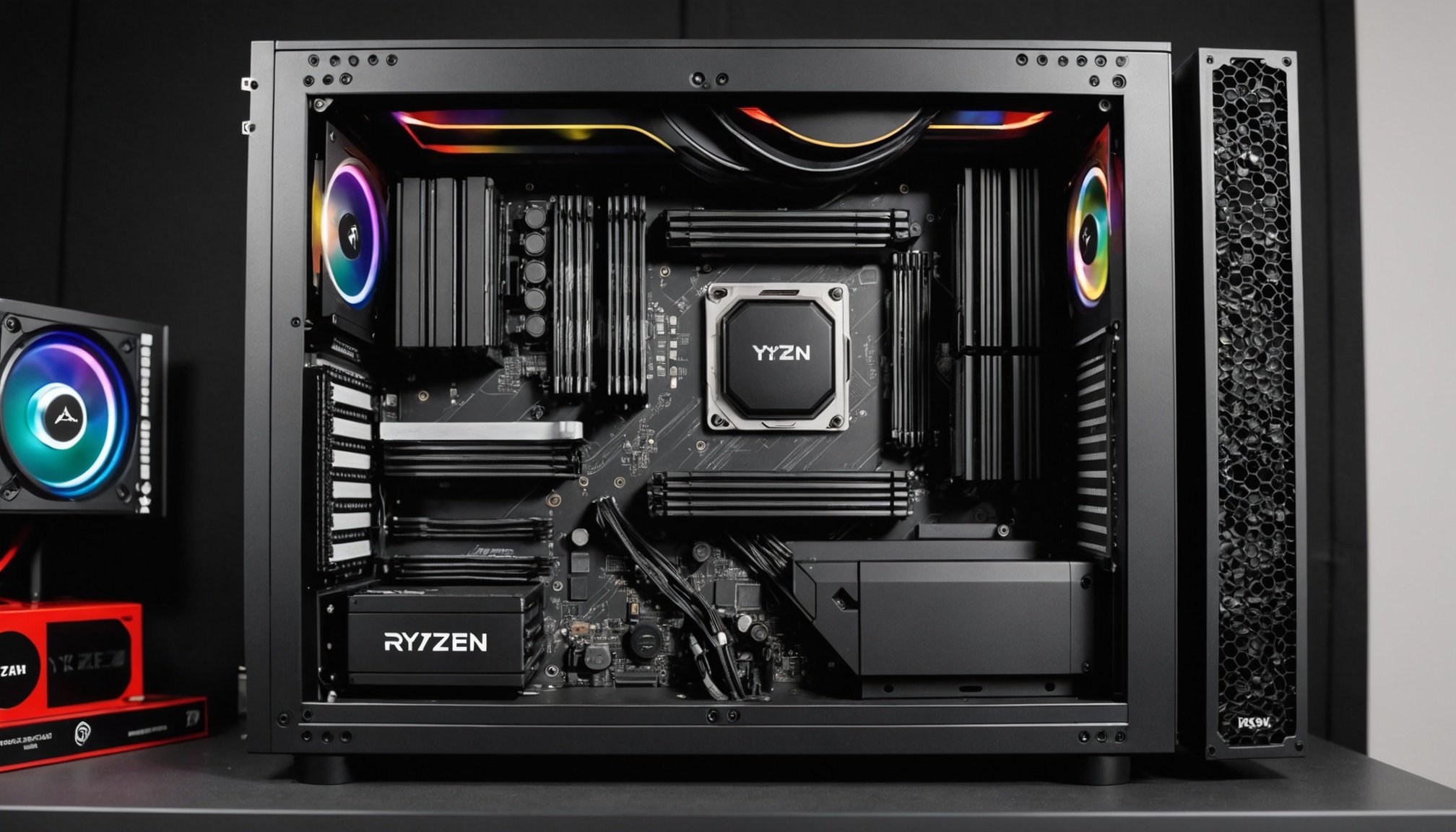Overview of Hardware Components
Understanding hardware components can elevate your computing experience. Here, we delve into three critical pieces: Ryzen 9 5900X, RTX 3090, and Corsair 5000D Airflow.
The Ryzen 9 5900X features 12 cores and 24 threads, making it a powerhouse for multitasking and gaming. With a base clock speed of 3.7GHz, it can accelerate to a max boost of 4.8GHz, providing robust performance for demanding applications.
Also to see : Unlocking remote work productivity: the ultimate guide to configuring your hp elite dragonfly with multiple monitors
Next is the RTX 3090, NVIDIA’s flagship GPU, offering unparalleled graphics capabilities with 24GB GDDR6X memory. It supports real-time ray tracing and DLSS, significantly enhancing gaming visuals. Its architecture allows for efficient 4K gaming, revolutionizing user experiences.
The Corsair 5000D Airflow case is engineered to optimize internal cooling. Its design prioritizes airflow with a high-airflow front panel and ample space for radiators and fans. This ensures that components like the Ryzen 9 5900X and RTX 3090 maintain peak performance without overheating.
This might interest you : Unlocking remote work productivity: the ultimate guide to configuring your hp elite dragonfly with multiple monitors
When these components combine in a single setup, users benefit from superior processing power, graphics rendering, and efficient thermal management. This synergy is essential for tech enthusiasts seeking high-level performance and reliability from their systems.
Optimizing CPU Performance
Understanding how to effectively optimize CPU performance can dramatically enhance your computing experience. When it comes to the overclocking Ryzen 9 5900X, precision and patience are key. Overclocking involves pushing your CPU beyond its standard operating speeds, which can significantly improve performance in demanding tasks such as gaming or video editing.
Overclocking Techniques
To unlock the full potential of your Ryzen 9 5900X, you’ll need to access the BIOS settings. Here, you can adjust parameters like the CPU clock multiplier and voltage. It’s critical to increment these settings slowly and test stability after each change. These adjustments can lead to increased performance, but be cautious as improper settings can cause instability or hardware damage.
Utilizing Thermal Solutions
Efficient CPU cooling is essential when overclocking. Using premium thermal paste and high-performance fans or liquid coolers can maintain the Ryzen 9 5900X temperatures within safe limits. Keeping your CPU cool under stress will help preserve its longevity and stability, ensuring a smooth overclocking journey.
With these techniques and cooling solutions, you can safely enhance your CPU’s performance, unlocking a new level of efficiency and power.
Enhancing GPU Performance
To truly leverage the RTX 3090’s capabilities, effective overclocking is vital. Overclocking this GPU involves tweaking its clock speed and memory frequencies for increased performance. This can provide smoother graphics and faster rendering in graphic-intensive applications and games. Precision is crucial—proceed with controlled increments to maintain stability.
GPU cooling is another key factor that amplifies the RTX 3090’s efficiency. High-performance GPU coolers, such as those with multiple fans or liquid cooling systems, help maintain optimal temperatures even during intense usage. Efficient cooling ensures that the overclocked GPU functions reliably without thermal throttling.
Optimizing graphics settings further enhances performance. Adjusting settings within your graphic software can maximize the RTX 3090’s potential, striking the perfect balance between quality and performance. Software tools assist in customizing these settings, facilitating a seamless experience.
Here are a few tips:
- Regularly check and update your graphic drivers.
- Explore various overclocking software options to find the best fit for your needs.
- Implement robust cooling solutions to keep your RTX 3090 running efficiently.
These strategies foster enhanced gaming and professional experiences with the RTX 3090, pushing its limits responsibly.
Efficient Thermal Management
Effective airflow management is fundamental to maintaining optimal temperatures in your system, especially when housing powerful components like the Ryzen 9 5900X and RTX 3090. The Corsair 5000D Airflow case excels in this aspect, offering a strategic setup that facilitates superior cooling.
Configuring Airflow
Optimizing airflow involves arranging components to minimize obstructions. Place fans to create a balance between intake and exhaust, typically with more fans as intakes. This configuration promotes efficient circulation and helps cool down critical hardware.
Selecting Fans
Choosing the right cooling solutions involves selecting fans tailored for either high airflow or static pressure. High airflow fans are ideal for places with no obstructions, such as case intake, whereas static pressure fans work best in radiator or heatsink setups.
Monitoring Temperatures
Regularly monitoring system temperatures ensures that your case setup operates within safe limits. Tools such as sensors and software allow you to track real-time data and adjust fan curves or placements as needed to optimise cooling efficiency.
These strategies collectively enhance the Corsair 5000D Airflow’s capacity to maintain a stable and cooled environment, ultimately increasing the longevity and reliability of your high-performance hardware.
Software Tools for Performance Monitoring
To ensure that your system runs optimally, implementing effective performance monitoring is essential. With advanced benchmarking software and precise hardware diagnostics, users can gain insight into their system’s capabilities.
Recommended Monitoring Tools
Performance monitoring tools come in various forms, each offering distinct features to cater to different needs. Popular options include software like MSI Afterburner and HWMonitor which provide real-time data on temperatures, clock speeds, and power consumption. These tools are essential in tracking how your Ryzen 9 5900X and RTX 3090 are performing during different tasks.
Benchmarking Techniques
Engaging in thorough benchmarking unveils your setup’s true performance potential. By using benchmarking software such as 3DMark or Cinebench, users can measure the effectiveness of overclocking or cooling modifications. This involves running specific tests designed to tax CPU and GPU performance, thus revealing any enhancements or need for further adjustments.
Analyzing Performance Data
Interpreting the data acquired from diagnostics is critical for making informed adjustments. For instance, identifying consistent temperature spikes during intense tasks may indicate the necessity for improved cooling solutions. Regular analysis supports a proactive approach to performance monitoring, ensuring your system benefits from long-term stability and efficiency.
Troubleshooting Common Issues
Encountering performance troubleshooting is common among users striving for optimal system efficiency. Identifying performance bottlenecks in setups with powerful components like the Ryzen 9 5900X and RTX 3090 is imperative. These bottlenecks can arise from inadequate cooling, outdated drivers, or incorrect BIOS settings.
Identifying Performance Bottlenecks
Bottlenecks occur when one component limits another, typically seen in mismatched CPU and GPU capabilities. Use hardware diagnostics to pinpoint underperforming parts. Slow processing or graphics rendering often signifies the need for adjustments.
Solutions for Stability Issues
Stability problems can manifest as system crashes or freezes. Solutions include updating drivers and firmwares, ensuring proper airflow, and verifying BIOS settings. Adjusting clock speeds or voltages can also resolve instability.
Optimizing Settings for Performance
Customising performance settings helps maximise efficiency. This includes altering graphical settings to balance quality and performance, plus leveraging overclocking for enhanced speeds. Use benchmarking software to monitor changes, ensuring that adjustments support stability and effectiveness without overheating.
Through these strategies, users can effectively troubleshoot and mitigate common issues, fostering a stable and responsive computing environment.










